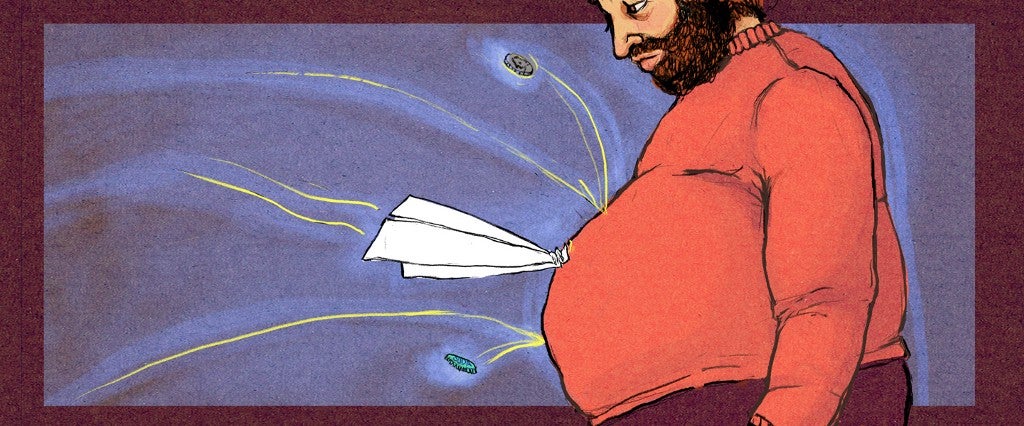In the early morning hours of New Year’s Eve, Austin police pulled over 48-year-old Florentino Herrera for running a stop sign. He subsequently failed a sobriety test and was nailed for a DUI, but the squad car camera detected a distinctly more troubling activity in the man’s car: Herrera was trying to destroy cocaine he’d hidden under his belly fat. While this is an ingenious use of a gut, it likely requires one to have the softer belly fat that is both better for hiding illegal drugs and (drinking and snorting aside) better for you, as guts go. Turns out it’s the hard gut that poses a real health risk.
The beer gut, the potbelly, the spare tire, ye olde Boomer Belly: You know if you have one, because at some point in your life someone has probably jokingly asked you how far along your pregnancy is. It’s a particularly odd endowment in men, because aside from the appearance of carrying a pregnancy to term, it’s not necessarily connected to being generally overweight. Men who otherwise appear “skinny everywhere else” can also have a rock hard, protruding gut that looks like you’re permanently smuggling a basketball.
It’s bad news. “Having a hard belly is like having a ticking time bomb in your body,” Dr. Jean-Pierre Despres told Men’s Health back in 2005. And because it increases the risk for diabetes and heart disease, he said, the hard belly is “worse than smoking or having high cholesterol.” (We can assume that makes it even worse than doing coke.)
Hard fat is worse than soft fat because, well, it’s hard. Called visceral fat, it’s packed tightly around your organs, in contrast to the peripheral fat that’s just under the skin and is relatively jiggly. How can you tell the difference? The soft stuff is pinchable, whereas you could bounce a quarter off that bowling ball.
You see it more commonly in older men because it’s related to age (being over 35), stress and hormones (because overproduction of cortisol leads to weight gain; testosterone drops in men as they age, too, making it harder to lose weight and contributing to muscle loss). It’s also about gender. Women tend to pack on weight in the hips and thighs, particularly during their fertile years; because that fat is farther away from the heart, they are less susceptible to weight-related heart disease. After menopause, though, that’s not the case, and women can gain as much visceral fat as men.
Regardless, the problem is that visceral fat is “biologically active”: It secretes hormones and molecules that wreak havoc by raising cholesterol and releasing proteins that increase inflammation. It also increases insulin resistance. All this means a greater risk down the line of Alzheimer’s, dementia, asthma and colorectal cancer.
What is to be done? Get the right amount of sleep now. A 2010 study of some 1,900 adults between the ages of 18 and 81, published in the journal Sleep, found that those under 40 who grabbed under 5 hours a night or over 8 hours a night had a greater increase in abdominal fat in a five-year follow-up. (After age 40, there was no observed association between sleep and fat accumulation.)
Second: Get moving (preferably doing something other than drunk driving). Experts say visceral fat is remarkably responsive to exercise — and it only takes about half an hour of moderate physical activity every day to start shedding it. Diet matters, too, and it’s the usual suspects you’ll want to eat more of: Fruits, vegetables, lean proteins and complex carbs. Cutting back on sugar and booze helps, but just because of the calories — the “beer belly” is technically a myth. The goal is to slim down to a waist under 40 inches in circumference.
One thing to be cognizant of: Dropping and doing a bunch of situps and crunches will certainly tighten up your abdominal muscles, but it won’t actually do anything for the visceral fat buried deep within — meaning it will only make your hard gut with tight muscles even more pronounced. In that case, better to follow Herrerra’s lead and take up a coke habit. At least that will get you nervously pacing around at home or in jail, both of which surely double as the gut-friendly exercise you need.

